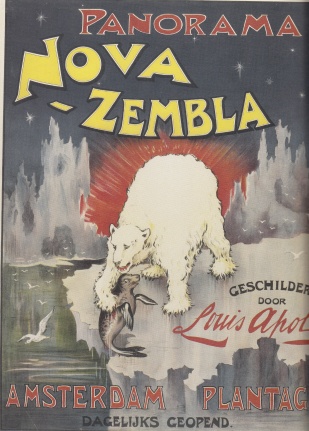Since my very first visit to the Netherlands, I have been surprised at the interest of Dutch people in one of the islands in the North of Russia, which they call Nova Zembla, from the Russian name Novaya Zemlya (“New Land”).
This topic of Novaya Zemlya drew attention since the time of the first Dutch explorer of the Arctic – Willem Barentsz, who died there in 1597. After him, this route was never followed by any of his countrymen. However, at the end of the XIX century, there was an expedition on the Dutch schooner Willem Barentsz to Spitsbergen and Novaya Zemlya in the Arctic Ocean. This trip was well organized and well equipped. For better documenting the polar landscape, it was accompanied by a Dutch artist Louis Apol (1850-1936).

Louis Apol is best known in the Netherlands – strangely –as the best painter of winter and Arctic landscapes. After the expedition to Novaya Zemlya, in 1896 he made the Panorama Nova Zembla in Amsterdam. Unfortunately, this work was destroyed and lost.

However, there are photos of it left, which are exhibited now together with many other Arctic paintings by Louis Apol in the Panorama Mesdag in Den Haag. These wonderful masterpieces of Louis Apol express all his fascination by this severe part of the world. They show the beautiful northern lights, the cold and deserted landscapes of the Arctic, quite often with a boat frozen into the ice.

They were made not during the trip, but much later and in better working conditions for the master. However, all of them are based on the sketches Louis Apol made during the trip. They also gave him the long-term inspiration to make many other paintings of the Arctic, even 50 years after his trip.

Interesting that in the internet one can read that this expedition went only to Spitsbergen. However the painter was in the meteorological station Malye Karmakuli in the South of the Novaya Zemlya. He even met and made portraits of the local Nenets people there.

References
https://en.wikipedia.org/wiki/Louis_Apol
https://www.panorama-mesdag.nl/laatste-kans-louis-apol-op-nova-zembla/

Thank you, Roza, for this interesting report. Could you tell more about the dutch expedition at the end of the 19th century? Did it had also scientific purposes? Did it happen in collaboration with Russian partners? And I wonder about the photograph of the panorama. If the original was lost, was there any attempt to recreate it or does the photograph shoes another panorama? It seems to be a modern photograph. We know about the growing public interest at the end of 19th and beginning of 20th centuries in exotic places and besides ethnographic museums and human zoos, the panorama is another visual form of representation. Did the panorama of Apol also contain cultural features and humans or are the portraits of Nenets people from other publications?
Hi Stephan. Thanks for your questions. I think that the original version of the panorama painting was lost during WWII. It means that photo’s could be made at the beginning of XX century.
Hi Roza, thanks for posting this fascinating report of what Dutch people see about the Nova Zembla Island in Northern Russia. As often, the untold story might be something to hear too. For instance, was there any specific reason for the destruction and lost of the 1896 Panorama Nova Zembla work of Louis Apol? I think this Anthropology blog has got quite many interesting stories/reports which we in the Anthropology team of the Arctic Centre, need to get these postings more reacheable to the wider public. A few ideas we had during the seminar in Pyha about lacris, that these could equally be added to the team’s evaluation of societal impact etc.
Thanks, Ayonghe.